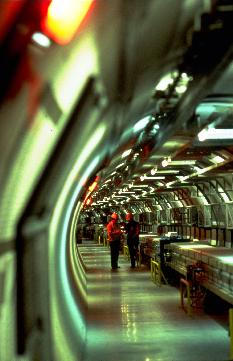The Super Proton Synchrotron (an older ring collider) was used to accelerate electrons and positrons to nearly the speed of light. These are then injected into the ring. As in all ring colliders, the LEP's ring consists of many magnets which force the charged particles into a circular trajectory (so that they stay inside the ring), RF accelerators which accelerate the particles with radio frequency (RF) waves and quadrupoles that focus the particle beam (i.e. keep the particles together). Rather than increasing the particles' velocities (which are already very close to the speed of light), the function of the accelerators is really to increase the particles' energies so that heavy particles can be created when the particles collide. When the particles are accelerated to maximum energy (and focused to so-called bunches), an electron and a positron bunch is made to collide with each other at one of the collision points of the detector. When an electron and a positron collide, they annihilate to a virtual particle, either a photon or a Z boson. The virtual particle almost immediately decays into other elementary particles, which are then detected by huge particle detectors.
 Detectors
DetectorsThe results of the LEP experiments allowed precise values of many quantities of the Standard Model—most importantly the mass of the Z boson and the W boson (which were discovered in 1983 at an earlier CERN collider) to be obtained—and so confirm the Model and put it on a solid basis of empirical data.
Dr. Bagger on precision and the mass of the Z boson at CERN: "The experimenters found that the Z boson got heavier at certain times of the day. This was a very high-precision experiment. They discovered that the patterns of the particle getting heavier corresponded to the tides. The gravitational adjustments due to tides slightly changed the shape of the collider over the course of the day. After adjusting for tidal effects, they found that the Z boson was heavier in spring and lighter in fall. This was because there's a lake in Geneva near the detector, that is drained in Fall to make room for the spring snow-melt. So the bigger lake in the Spring was making the particle heavier. After correcting for both of these factors, they found that the particle got suddenly heavier multiple times during the day, at the same times. This was because a train runs near the detector whose electromagnetic fields were disturbing the experiment. This is how precise the experiment was."
Precision measurements of the shape of the Z boson mass peak constrained the number of light neutrinos in the standard model to exactly three. Near the end of the scheduled run time, data suggested very tentative but inconclusive hints that the Higgs particle might have been observed, a sort of Holy Grail of current high-energy physics. The run-time was extended for a few months, to no avail.


No comments:
Post a Comment